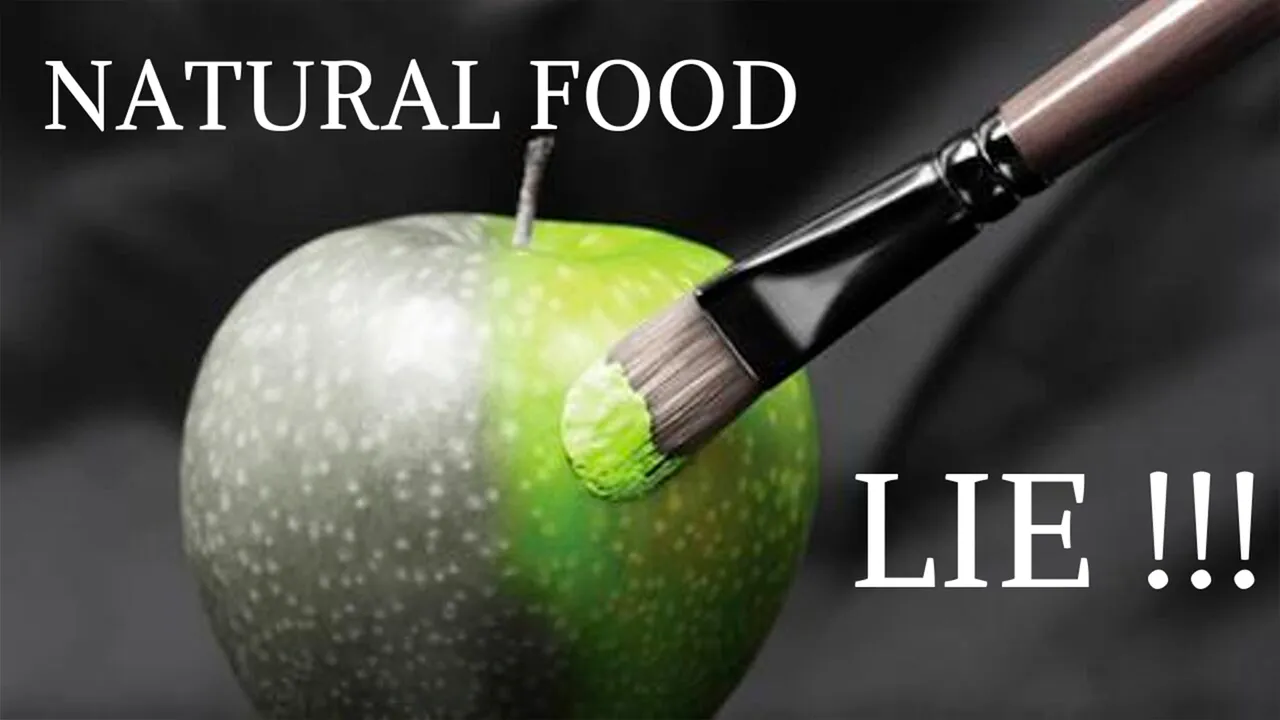
Natural food LIE, is a TRICK to make you BUY healthy stuff || Natural flavors exposed
Though the term is meant to imbue foods with a beneficial halo implying health and nutrition, the inclusion of natural flavor doesn’t in any way mean that a product is actually good for you. Products that boast natural flavor on their packaging can still be chock full of artificial sweeteners, trans fats, genetically-modified proteins, and any other number of nutritional lies. To be naturally flavored doesn’t even preclude something from also being artificially flavored.
The U.S. Food and Drug Administration (FDA) defines natural flavor as:
“…The essential oil, oleoresin, essence or extractive, protein hydrolysate, distillate, or any product of roasting, heating or enzymolysis, which contains the flavoring constituents derived from a spice, fruit or fruit juice, vegetable or vegetable juice, edible yeast, herb, bark, bud, root, leaf or similar plant material, meat, seafood, poultry, eggs, dairy products, or fermentation products thereof, whose significant function in food is flavoring rather than nutritional.”
What a mouthful! If that definition sounds all-encompassing to you, you’re not alone. Food manufacturers take full advantage of the generous FDA natural flavor guidelines at every conceivable opportunity when it comes to marketing products meant for consumption. The Environmental Working Group even found that among 80,000 food products studied, only salt, water and sugar appear on nutrition labels more often than natural flavor. In meaning nearly anything, it effectively means nothing.
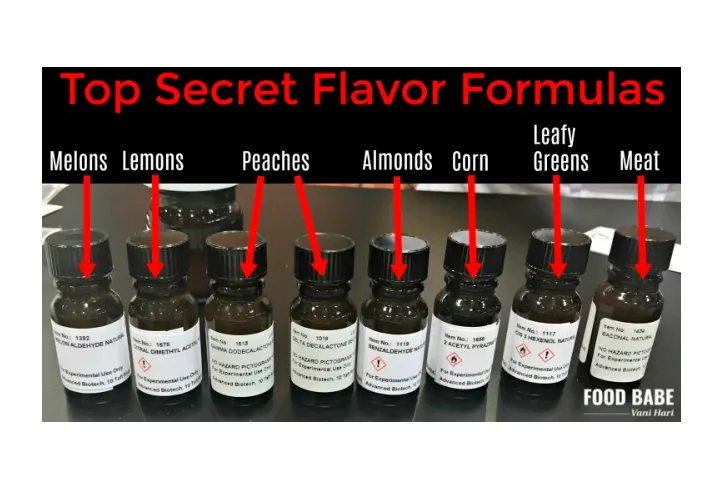
But things get even trickier still, as manufacturers aren’t actually required to list which of the oils, distillates, essences, juices or other food products are included to create a discernible natural flavor. And up to 100 different sources can be used to create a product’s singular natural flavor. Complicating matters even further, the FDA considers more than 3,000 chemical food additives to be, you guessed it, natural flavors.
So what is natural flavor, really? It’s an essential oil, or an essence, or a product of fermentation, or one of 3,000 chemical additives, or actually 100 different things vaguely related to food all conveniently (and anonymously) lumped together to form a cohesive taste reminiscent of a single real world flavor. Or, to put it another way, mostly just a lot of marketing speak.
Flavor companies own these proprietary formulas… making it near impossible to find out exactly what’s in them. You’d like to think that “natural apple flavor” is just some juice extracted from an apple and inserted into the food. Nope. That “natural apple flavor” needs to preserved and stabilized and has agents added to help it mix well into a product. This is why flavors can contain upwards of 100 ingredients like propylene glycol, polysorbate 80, BHT, BHA… all considered “incidental additives” not required to be labeled by the FDA. The FDA doesn’t require companies to tell you what is in the flavors they use. It’s a complete mystery ingredient.
You see, a governmental or independent agency does not approve or oversee the safety of the food flavors. Instead, a flavor industry trade group, the Flavor and Extract Manufacturers Association (FEMA), has assembled their own “independent” panel of scientists who review and approve new flavors as Generally Recognized As Safe (GRAS). These scientists are paid by the FEMA trade group (who ultimately get their funding from flavor companies).
And, of course, these FEMA panel scientists are supposed to be independent and free of conflicts of interest, but many questions have been raised about their closed-door evaluations and lack of transparency with the public. The fact that this panel is assembled and paid for by a flavor company trade group is concerning to say the least, don’t you think?
Public advocacy groups have questioned FEMA’s processes and called on the FDA to ban certain flavor substances that have known links to cancer, but little has been done. Some chemicals used to make flavors, like Diacetyl (which is used to make buttery flavor), are highly dangerous for those that work around them… but we are supposed to eat them and be okay? Consumers want to know what’s in these flavors and what research has been done proving their safety, but we essentially get the door slammed in our faces when we ask.
The laws surrounding these flavors are lax to say the least, and companies don’t have to tell you much about what they really are. Labels on food typically just say “natural flavors” or “artificial flavors” and don’t explicitly tell you what differences are between them.
It’s good to know that there are some stark differences between artificial flavors, natural flavors, natural strawberry flavors, organic raspberry flavors, natural essences, organic extracts, etc… And while these are all largely the same, some of the flavors added to food are better than others.
So, if you’re like me and want understand exactly what you’re eating and to know more about what these labels, there is this Flavor Cheat Sheet below to break it all down.
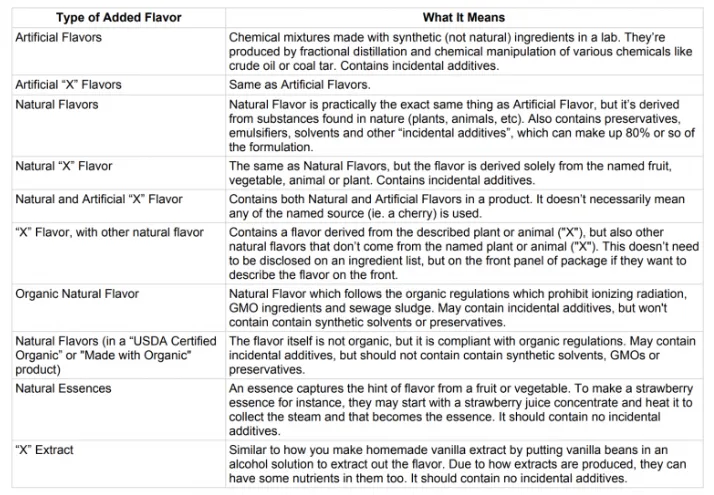
Artificial Flavors or Artificial “X” Flavors
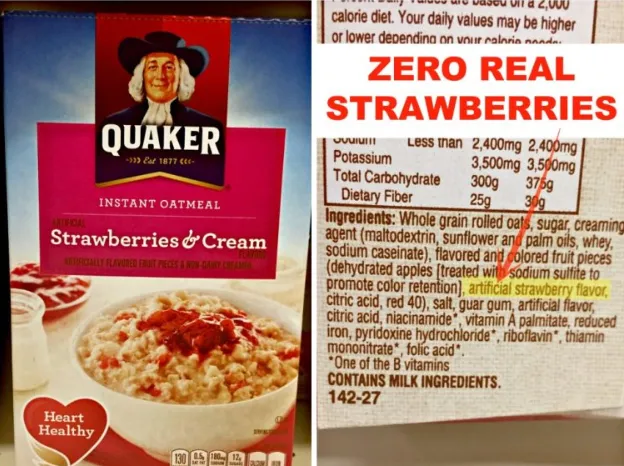
Artificial flavors are chemical mixtures made with synthetic (not natural) ingredients in a lab. They’re produced by fractional distillation and chemical manipulation of various chemicals like crude oil or coal tar. Artificial vanilla flavor can be made from wood pulp. With artificial flavors, chemists can make anything taste like a strawberry without any actual strawberries (or any actual food for that matter), which is a really horrible thing if you care about health. But it’s a great thing for food manufacturers because artificial flavors are much cheaper than using real food (or even natural flavors).
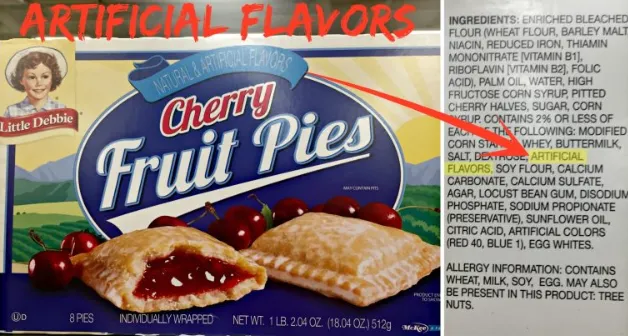
Natural Flavors
Natural Flavor is practically the exact same thing as Artificial Flavor, but it’s derived from substances found in nature (plants, animals, etc). So, the flavor is DERIVED from natural things, but it’s important to remember that this isn’t all it contains. Remember, flavors typically contain preservatives, emulsifiers, solvents and other “incidental additives”, which can make up 80% or so of the formulation. Some of the most common incidental additives in flavors include: sodium benzoate, glycerin, potassium sorbate, and propylene glycol (none of which are labeled).
Chemists create these complex formulations in a lab, isolating and blending specific flavors extracted from upwards of hundreds of compounds, some of which may be GMOs. These compounds can come from substances that are nowhere close to the actual thing.
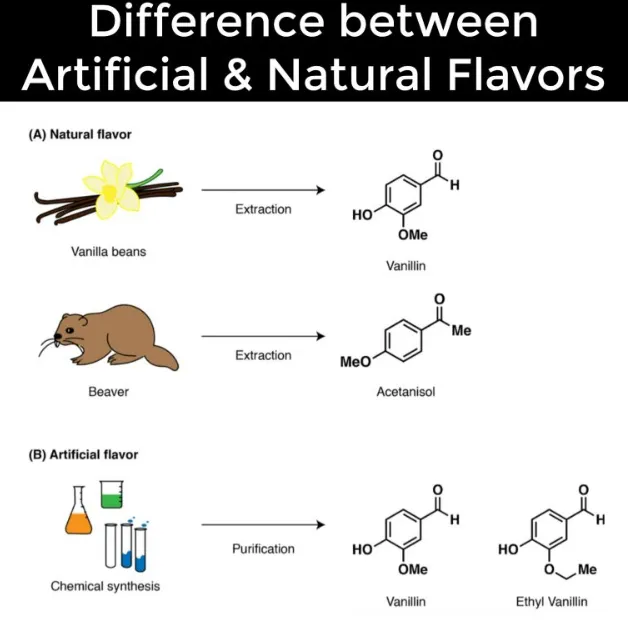
Natural “X” Flavor
In general, if you see something like “Natural Cinnamon Flavor” this means that the flavor is derived solely from the named fruit, vegetable, animal or plant, which in this case is cinnamon. In other words, if you see “Natural Raspberry Flavor” on a product, the flavor didn’t come from a beaver, but actual raspberries. The reason food companies use this kind of flavoring is because it’s cheaper than using the actual ingredient in it’s raw form. The flavor also can be synthesized to be the best “one millionth” part of the taste of a substance — something definitely not found in nature. Incidental additives still apply, of course.
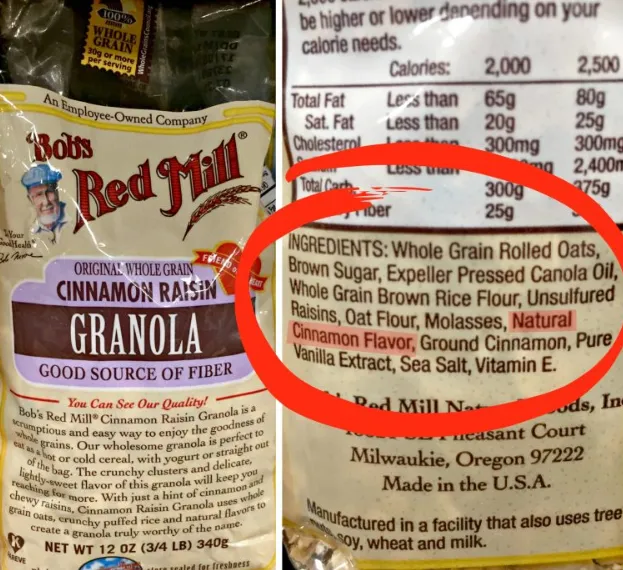
Natural and Artificial “X” Flavor
You’ll see a label like this when there are both natural and artificial flavors in a product. It doesn’t necessarily mean any of the named source (ie. a cherry) is used.
Organic Natural Flavor
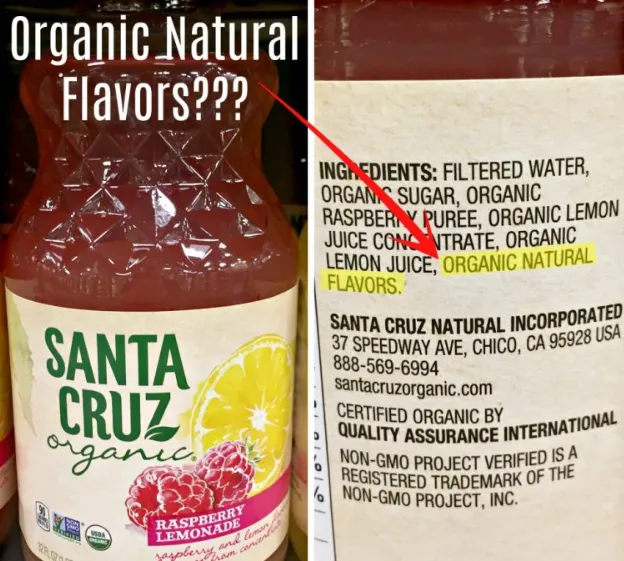
A lot of people have told me they’re surprised that organic foods can contain natural flavors. While it’s not ideal, at least “Organic Natural Flavor” is made just like other organic ingredients and needs to follow the same regulations. That means that organic flavors won’t contain synthetic solvents or preservatives, and no GMOs. Some the the “incidental additives” banned from organic flavors include propylene glycol, mono and diglycerides, BHT, BHA, and polysorbate 80.
If you want to know what you are actually drinking from zero calories sodas watch the following video.
Natural food LIE, is a TRICK to make you BUY healthy stuff || Natural flavors exposed